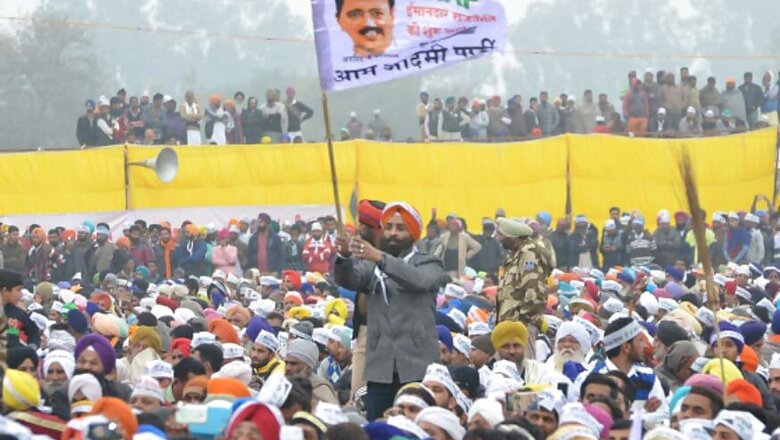
views
Chandigarh: “Dilli jeeta hai toh Punjab toh hum jeet hi lenge (We won Delhi, we can surely win Punjab)”. These were the sentiments of a buoyant Aam Aadmi Party worker in Amritsar, reflective of the Punjab unit’s resurgent hopes for the 2022 assembly elections.
While the AAP has signaled its national ambitions by calling for people to partner with it in nation building, Punjab is the only state with significant AAP presence after Delhi.
“Delhi has made it clear. Only the party that delivers will get votes. And this message will be clearly seen in 2022 in Punjab,” said an exuberant Aman Arora, AAP MLA from Sunam.
Arora was also confident that the party will carry this momentum into the battle for Punjab. “Definitely, there is a very positive message in Delhi results. We have a very big presence in Punjab and this will be an advantage for us,” he said.
The Aam Aadmi Party is hoping to ride on a possible anti-incumbency wave against the Amarinder Singh-led Congress government, and capitalise on a weakened Akali Dal to emerge triumphant in 2022.
Besides, the AAP projects itself to be a secular party, and in Punjab, unlike other states, voters have been rarely polarised along the lines of religion. Like the AAP, the Congress and the Akali Dal, too, swear by their secular character. The AAP fits in this secular fabric much better than the BJP which has been trying hard to make inroads in the state.
But it is easier said than done. The popularity graph of the AAP has taken a sharp hit ever since it debuted in Punjab.
The AAP’s first electoral foray after coming into existence was the 2014 general elections, that too only in Punjab. The party surprised even itself with four seats — Patiala (Dr. Dharamvir Gandhi), Sangrur (Bhagwant Mann), Fatehgarh Sahib (Harinder Singh Khalsa) and Faridokt (Prof. Sadhu Singh). The AAP had also bagged an impressive 24.39% vote share in the state, just 2% shy of the ruling Akalis’ tally.
Three years later, in the Punjab assembly elections, the party secured 23% votes, dropping marginally. It bagged 20 seats in the 117-member assembly, trumping even the Shiromani Akali Dal (SAD), which had been in power for a decade.
However, two years down the line, the party received its worst drubbing ever, winning just one Lok Sabha seat in Punjab last year — Bhagwant Mann from Sangrur. The vote share also dropped drastically to 7.38 percent.
The drop in AAP’s popularity in Punjab can be attributed to the rot within the state unit, which is a divided house.
In 2014, AAP had fielded 13 candidates, including Sucha Singh Chhotepur, in the Lok Sabha elections. In 2019, the only candidates left with it were then sitting MPs Bhagwant Mann and Prof. Sadhu Singh. Dr. Dharamvir Gandhi and Harinder Singh Khalsa had turned rebels. While Gandhi floated his own outfit, Khalsa joined the BJP.
The seeds of rebellion and factionalism were first sown in August 2016 when AAP’s central leadership unceremoniously removed state president Sucha Singh Chhotepur, accusing him of corruption. A trust deficit surfaced soon and state party leaders accused the Delhi leadership of meddling in day-to-day affairs.
Dissent started brewing within, and in August 2018, former leader of opposition Sukhpal Singh Khaira, after being removed from the post in July, turned rebel and held a convention in Bathinda, declaring the state unit ‘autonomous’.
Six other MLAs joined him at the convention — Kanwar Sandhu (Kharar), Pirmal Singh (Bhadaur), Jagdev Singh Kamalu (Maur), Nazar Singh Manshahia (Mansa), Master Baldev Singh (Jaito) and Jagtar Singh Jagga (Raikot).
The party suspended Khaira and Sandhu for anti-party activities. Later, Khaira floated his own outfit, Punjabi Ekta Party, taking along five rebel MLAs, and resigned from the state assembly.
Mansa MLA Nazar Singh Manshahia and Ropar MLA Amarjeet Singh Sandoa joined the Congress. MLAs from Jaito and Dakha, Master Baldev Singh and Harvidner Singh Phoolka, resigned from the AAP and the House.
On account of these defections and resignations, the effective strength of the rebellion-riddled AAP in the 117-member house has been reduced to 11, and is on the verge of losing its status as the main opposition party. With its 15 MLAs and three from the BJP, the Akali Dal can now stake claim to the leader of opposition post from the AAP.
These rebellions dented the party badly and the result in 2019 Lok Sabha polls was obvious.
For the Aam Aadmi Party to repeat its Delhi feat in Punjab, it would have to reach out to the rebels, or for that matter, come up with a strategy to right its wrongs. 2022 might be AAP’s best chance ever.
The ruling Congress says the AAP doesn’t stand a chance at all. “Elections in Delhi and Punjab are entirely different. The AAP didn’t win the Delhi election with its ability. It is the democratic, nationalist forces which have made Kejriwal a winner. This is a verdict against Narendra Modi, not an affirmation of Kejriwal’s policies. We don’t face any challenge from anyone in Punjab. We have a party of real nationalists in Punjab led by Capt. Amarinder Singh. Hence the voters will vote for the Congress in 2022,” senior Punjab Congress leader Raj Kumar Verka said.




















Comments
0 comment